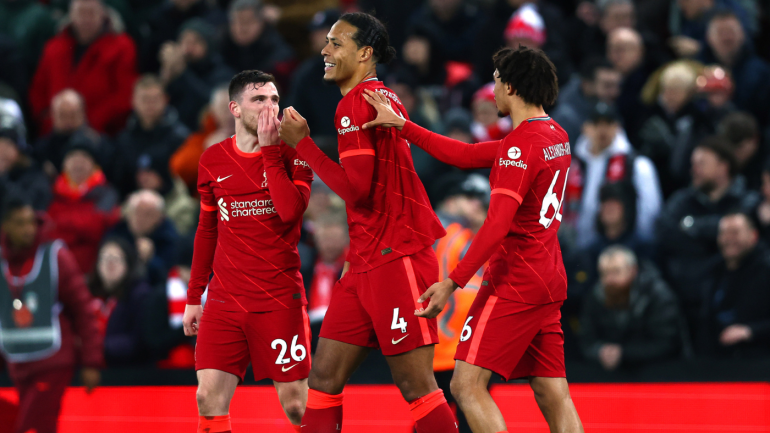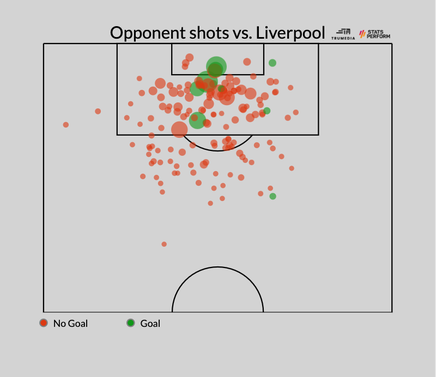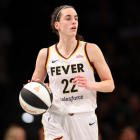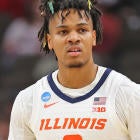
It is scarcely two months since Jurgen Klopp christened his rebuilt squad as "Liverpool 2.0," but already they find themselves in a scenario that would be intensely familiar to their first iteration. Arsenal might like to claim otherwise but the Reds' visit to the Etihad Stadium has the feel of a clash between the two best teams in the country... perhaps even the continent.
This will be the fourth time these two have faced off while occupying first and second in the Premier League, the great rivalry of recent English history resumed after trying recent times at Anfield last season. City and Liverpool are one and two for goal difference, expected goal (xG) difference, non-penalty expected goal (npxG) difference and, of course, points. Normality, it appears, has been restored.
When it comes to City there is precious little to doubt in those numbers. Without the injured Kevin De Bruyne and with Ilkay Gundogan gone to Barcelona, they may not be the force that swept every competition possible last spring, but these team have eased out of the blocks frequently enough to convince any skeptics that they will ease through the gears when it matters the most. There might have been some tweaks due to injuries and exits, but the guiding principles of Pep Guardiola remain largely unaltered.

Golazo Starting XI Newsletter
Get your Soccer Fix from Around the Globe
Your ultimate guide to the Beautiful Game as our experts take you beyond the pitch and around the globe with news that matters.
Thanks for signing up!
Keep an eye on your inbox.
Sorry!
There was an error processing your subscription.
You could not quite say the same for Liverpool. They might still play with the recognizable intensity of a Klopp team, but that is being channeled in different directions, most notably through the guts of the pitch. On their ascent to the continental and domestic summits, no team was more effective at spreading the game wide than Liverpool, who would set Trent Alexander-Arnold and Andrew Robertson on the outer limits, both to create lanes for their inside forwards and to exploit the crossing talents of the former in particular. As recently as 2020-21 they were delivering 16.3 crosses per game in the Premier League, one of the high watermarks for the competition.
Now that number is down at 11.4. Dominik Szoboszlai is bringing dynamism into the midfield that was hardly a calling card of Jordan Henderson. Meanwhile, Alexander-Arnold is the latest full back to invert into midfield, averaging 23.9 percent of his touches in the middle channel of the field outside both boxes. In 2020-21 that percentage was just 7.7. As the right back has drifted infield, so his counterpart on the left flank has tucked in to work as something approximating a third center back.
Those tweaks lead to questions over the great unknown that is Liverpool's defense. The emphasis there should be on the word unknown, because while the 12 game mark tends to be a sufficient sample size to draw reasonable conclusions, Liverpool's start to the season has been weird, four red cards in their first seven games weird. Those extended periods go some of the way towards explaining why Liverpool have given up a fair chunk more npxG to their opponents than the rest of the top two, 14.7 to City's 10.4 and Arsenal's 8.6.
Don't miss CBS Sports Golazo Network's Morning Footy, now in podcast form! Our crew brings you all the news, views, highlights and laughs you need to follow the Beautiful Game in every corner of the globe, every Monday-Friday all year long.
Giving up two or so xG will happen when you're down to 10 men against Newcastle or nine against Tottenham (to say nothing of the process that got them there), but there have been vulnerabilities that have been prodded at when Liverpool are at their full compliment too. The 2-2 draw with Brighton was altogether too hurdy-gurdy for a side with title aspirations. That same level of team might have questions of giving up 16 shots to Brentford, of how easily Luton waltzed through a chaotic defense on their way to a goal at Kenilworth Road earlier this month.
Maybe the red cards explain away a lot of this, but Liverpool have given up more than 100 extra touches in the box than City this season and have allowed 94 shots inside the penalty area to City's 63, Arsenal's 65. To an extent Liverpool's early season title push has the feel of the Gunners' run in the first 20 or so league games of last season: a fearsome attack can get you very far but it is hard to build a championship defense when you're giving up 1.2 xG per game... even if you do have Alisson in goal still.

While this has the feel of a second iteration of Klopp's team in midfield and attack, the defense is largely the same personnel trying to do different things. Be it (the now injured) Andrew Robertson or Kostas Tsimikas, Liverpool don't have a left back who is an obvious fit inverting in the same way as Nathan Ake or Ben White. Alexis Mac Allister has largely shone as the table setter for Liverpool's attackers but he is hardly as adept at snuffing out attacks as Fabinho while there is no one in this team who quite has Henderson's ability to plug the gaps Alexander-Arnold leaves.
There is of course a simple solution, one plucked straight from the Liverpool 1.0 playbook. The sheer aura of prime Virgil van Dijk would blot out these weak points. Last season he was not that player. This year, maybe he is? He certainly seems to think so. "Last year saw ups and downs, good games and less good games," said the Dutchman over an international break where his form with the Netherlands has come under the microscope. "I'm held to a very high standard and I still am. That's what I've created and I enjoy that. If that's not the case, then something's not right.
"But I feel like I am in good moment physically and mentally and I feel like I am important. I just feel very good and I want to keep going. For me the most important thing is how I feel, what my team-mates feel about me and especially the manager. All the noise from the outside, whether it is very good or very bad, you can't do anything with it."
At 32, he looks at least something like the player of old. This season he wins 80.5 percent of his duels, last year he was just below 70 percent (he is also having to compete a lot more, rarely a good sign for a center back). The gap between Van Dijk and the next best outfielder on the list (Ake) is more than five percentage points. In your mind's eye you can already see the center forwards bouncing off him as they chase a long ball down the channel.
Van Dijk is not going to plug every gap in this Liverpool defense. After all, he has only missed two of the 12 Premier League games that have contributed to this intriguing early start. His steady improvements as the season has gone on, however, do offer hope to Klopp that the Reds can put together a title-winning defense. If he can impose himself on Erling Haaland in the same way he would have two or three years ago then there will be good reason to believe that Liverpool 2.0 can achieve just as much success as the side that Van Dijk anchored with such aplomb.





















